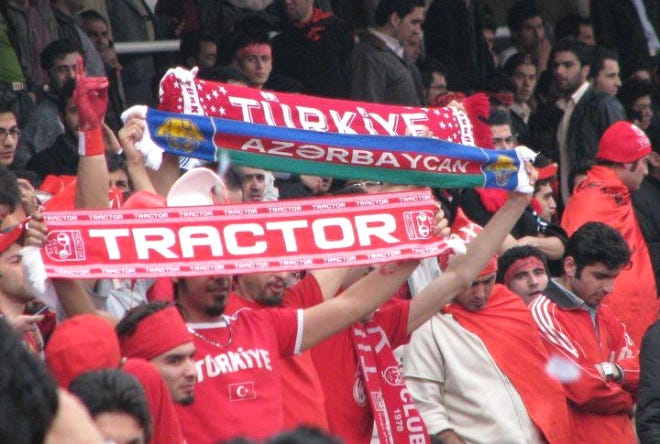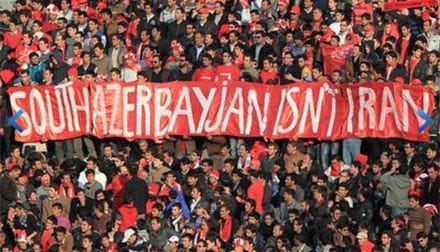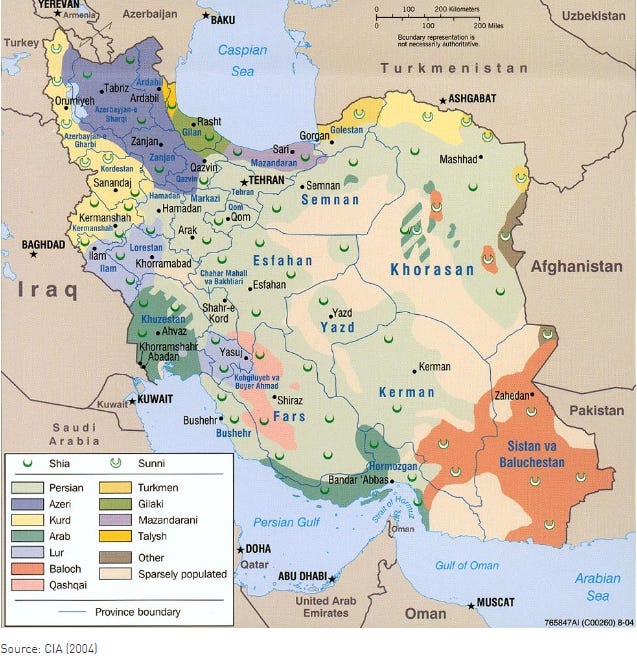Tractor-Sazi: The Football Club of Azerbaijanis in Iran
How a football club is helping an ethnic group to maintain its identity
The city of Tabriz is located in northern Iran, specifically in the region that is called Iranian Azerbaijan or South Azerbaijan. Tractor-Sazi is the city’s football club.
One of its fans' favourite choruses is “Tabriz, Baku, Ankara.”
But why do they chant the names of the capitals of Turkiye and the Republic of Azerbaijan in addition to that of their city?
To answer this question, we need to analyze the history of this region and that of the Azerbaijani people. This is the story of Tractor, the club of Iranian Azerbaijanis.
South Azerbaijan
To understand how we got to the present situation, we need to take a long step back in history. Precisely in 1813, when due to the war between Iran and Russia and according to the Gulistan treaty and the Turkmenchay treaty of 1828, Azerbaijan was divided into two parts. Northern Azerbaijan came under Russian authority, while southern Azerbaijan came under Iranian authority.
Both Azerbaijanis tried to be independent. The northern one declared itself independent under the name Azerbaijan Democratic Republic in 1918. At the same time, the southern one declared its independence in 1945. Both, however, lost their sovereignty. The northern one became part of the USSR after the end of World War II, and the southern one returned under Iran.
The collapse of the USSR, described by Vladimir Putin as “the greatest geopolitical catastrophe of the century”, allowed Azerbaijan to become independent again. Instead, South Azerbaijan remained part of Iran. A heartfelt fact is that 8 million Azerbaijanis are living in Azerbaijan, while there are reportedly anywhere from 12 to 17 million in Iran.
Iranian Azerbaijanis live in the regions of Iran that border Azerbaijan. Which was also part of the Persian empire. Administratively, Azerbaijanis completely dominate the regions of western and eastern Azerbaijan, Ardabil, and Zanjan, and also make up more than half of the population in the provinces of Hamadan and Qazvin.
Azerbaijanis played a key role in the history of the Persian empire, occupying important positions in the elites. The Safavids, the dynasty that created present-day Iran, were of Azeri origin. The dynasty brought about the most important change in the Persian empire: the transition to Twelver Shiism (today the official religion of the Islamic Republic of Iran). The Persians, after being conquered by the Arabs, were forced to change their religion from Zoroastrianism to Sunni Islam. Sunnis were also the Ottomans, with whom the Safavids shared descent, but from whom they wanted to distinguish themselves by embracing Shiite Islam.
The ethnogenesis of the Azerbaijani people is complicated. Apart from their main Turkic nomadic ancestry, they also constitute proto-Caucasian tribes and Iranian farmers. However, in linguistic terms, they are closer to the Turks since their language is included in the Turkic group of the Altai language family and is very different from the Iranian group of the Indo-European language family.
TRT World
Azerbaijanis are considered a related people in both Turkiye and Iran. What most distinguishes Azerbaijanis living in Azerbaijan from those living in Iran is the fact that under Tehran's power, the latter have been Iranized and with time are in danger of losing their identity. Unlike their “Russian-Soviet” compatriots, who, thanks to the Declaration of Independence, have created a state, in which they have the possibility of maintaining Azerbaijani identity, culture and language. The Iranian Azerbaijanis are not allowed to have their language taught in schools.
Tractor-Sazi
Azerbaijan is our land,
Tractor is our pride,
Courtesy and honour is our slogan,
Tractor is our pride.
The club was founded in 1970 to provide a football club to the city's workers and residents. Tabriz is a melting pot of Azerbaijani, Shiite Muslims, Christian Armenians and Bahai minorities. Over the years, the team has become increasingly important, primarily on an identity level, becoming an identity symbol for the Azerbaijani population, which is the second-largest ethnic group in Iran.
In addition, the team has also improved in terms of results, winning 2 cups and reaching second place in the local league. Investments by billionaire Mohammad Reza Zonouzi Motlagh owner of ATA Airlines, Tabriz Iran Khodro, Tourism Bank and Saman Bank played an important role. It should be noted that former AC Milan player, Kevin Constant, also played for the club.
For its fans it is much more than a club, it is an identity symbol and the stadium has become a place where they can carry out their protests against power. The club has 500,000 members. To the Iranian regime, however, it is a threat.
To better understand the importance of the club to the Iranian Azerbaijani people, it is necessary to list several examples of how fans express their identity through the team. For example, the name of the stadium. It was initially given the name Yadegar-e Imam, after Ahmad Khomeini, the son of Ayatollah Ruhollah Khomeini. Tractor fans instead call it Sahand, meaning one of the highest mountains in Iranian Azerbaijan.
Further examples are the flags of Turkiye and Azerbaijan that are flown during matches. Also, another case worth mentioning is the one that took place on January 5, 2018. When during a match, fans started chanting “Arabian Gulf” to show their support for the Arabian Gulf states, which are Iran's enemies. Another chorus they chanted was “Lake Urmia and the Caspian Sea belong to us [Azeris], as the Gulf belongs to Arabs.”
It is evident that the supporters avoid mentioning the Persian Gulf, and this exercise of detaching themselves from the Iranian government and Persian culture through language is synonymous with how they do not feel an integral part of Iranian society.
It’s worth mentioning that the Azerbaijanis for years have been victims of anti-Turkish, racist, and dehumanizing chants in Iranian stadiums. As highlighted by the report called “Global Guide to Discriminatory Practices in Football,” which examined “discriminatory practices displayed inside football stadiums around the world” published by the FARE (Football Against Racism in Europe).
The complexity of Iran
Iran still considers itself an empire, and among the many challenges it faces at the moment, that of a heterogeneous ethnic composition is certainly the most complicated. Different ethnic groups live in Iran, such as Azeris, Kurds, Baluchis, Turkmen, Arabs, Qashqai and many more. The challenge for Tehran is to be able to maintain internal cohesion. This means preventing ethnic minorities from turning to power. Evidence of this was the street protests that erupted after the killing of Jina Mahsa Amini, a girl of Kurdish origin.
One of the most convenient tools for Iran is to compact the internal front using an external enemy, be it the United States of America or Israel. A difficult exercise when it comes to the Azerbaijani population, given the relationship between Azerbaijan and Israel. Israel and Turkiye are military allies of Azerbaijan. An alliance that enabled Baku to retake Nagorno-Karabakh. Therefore, it becomes difficult for Tehran to compact the Azerbaijani people internally using the Israel card.
How important the Iranian Azerbaijanis are to Iran can be understood from the fact that it is the only ethnic group that is accepted in the seats of power. Supreme Leader Khamenei is of Azeri descent and speaks in Azeri when he has to address that section of the population. The new president Masoud Pezeshkian is also of Azeri descent. He’s also a Tractor-Sazi supporter.
Protests by non-Persian-speaking ethnic minorities have increased in recent years. People living in South Azerbaijan, Kurdistan, and Baluchistan have raised their voices, demanding more rights and especially recognition of their language and ethnic heritage. The passage that Tehran cannot afford to recognize. If these freedoms were given, these people would move closer and closer to the desire to break away completely from Tehran and try to create an independent state.
One of the imperatives of an empire is to assimilate the people within it. It must do this because, in the event of war, it needs all the people within it to fight for the cause and not against it. The United States of America is the most successful example when it comes to the assimilation of different peoples. Throughout its history it has assimilated Germans, Irish, Italians and Mexicans, just to name a few. China, for example, is doing it with the Uighurs. Iran is trying, by denying the minority ethnic groups the freedoms they demand. But the pressure is mounting, and it is becoming more and more difficult for Tehran to handle.
The importance of sports
The history and reality of Tractor allow us to understand a complicated country like Iran. In this case, it goes far beyond sports. Entertainment and sports results are of relative importance. The main function of this team is to enable its fans to keep Azerbaijani identity, culture, and language alive.
The fans use Sahand Stadium as the main location where they focus all their efforts. A place that is supposed to be neutral and where people should go exclusively to watch their team's matches, but over time it has become a symbol of protest and revolt. It has become so because it remains a protected place and where people feel safer to shout and express their ideas. Aware that if they did it in the streets, they would pay the consequences.
Fans sing choruses, celebrate the Azeri language, demand for education in their mother tongue, remember the fallen Azerbaijani heroes, and mention important geographical places in Azerbaijani history. All these things together are key assets that represent an ethnic alternative to the Iranian one that prevails in the country's narrative.
Thus, we return to the chorus I mentioned at the beginning of the text “Tabriz, Baku, Ankara.” Now it is easier to understand why the capitals of the Republic of Azerbaijan and Turkiye are named during the Tractor match. The three cities share a common language and a sense of kinship, routed in the Turkic ancestry. Many of the choruses and protest demonstrations mention pan-Azerbaijani and pan-Turkish sentiments. Feelings that would like the cultural and political union of all Turkic peoples. A football club will never be so important as to cause a power shift or an ethnic minority to become able to declare independence. Its importance, in this case, lies in keeping the identity of a people alive and allowing us outsiders to understand the complexity of this situation.
Sources:
- https://www.europarl.europa.eu/doceo/document/E-9-2023-003110_EN.html
- https://assembly.coe.int/nw/xml/XRef/X2H-Xref-ViewHTML.asp?FileID=10018&lang=en
- Tractor Sazi FC and the Civil Rights Movement of Turks in Iranian Azerbaijan, Vahid Rashidi
- https://www.babagol.net/blog/2018/10/17/tractor-sazi
- https://pomeps.org/football-as-a-platform-for-ethnic-identity-assertion-in-iran







Interesting read!